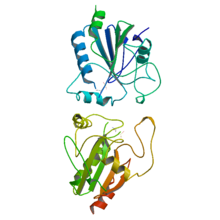Glutathione peroxidase
| Glutathione peroxidase | |||||||||
|---|---|---|---|---|---|---|---|---|---|

Crystallographic structure of bovine glutathione peroxidase 1.
|
|||||||||
| Identifiers | |||||||||
| EC number | 1.11.1.9 | ||||||||
| CAS number | 9013-66-5 | ||||||||
| Databases | |||||||||
| IntEnz | IntEnz view | ||||||||
| BRENDA | BRENDA entry | ||||||||
| ExPASy | NiceZyme view | ||||||||
| KEGG | KEGG entry | ||||||||
| MetaCyc | metabolic pathway | ||||||||
| PRIAM | profile | ||||||||
| PDB structures | RCSB PDB PDBe PDBsum | ||||||||
| Gene Ontology | AmiGO / EGO | ||||||||
|
|||||||||
| Search | |
|---|---|
| PMC | articles |
| PubMed | articles |
| NCBI | proteins |
| Glutathione peroxidase | |||||||||
|---|---|---|---|---|---|---|---|---|---|
| Identifiers | |||||||||
| Symbol | GSHPx | ||||||||
| Pfam | PF00255 | ||||||||
| InterPro | IPR000889 | ||||||||
| PROSITE | PDOC00396 | ||||||||
| SCOP | 1gp1 | ||||||||
| SUPERFAMILY | 1gp1 | ||||||||
|
|||||||||
| Available protein structures: | |
|---|---|
| Pfam | structures |
| PDB | RCSB PDB; PDBe; PDBj |
| PDBsum | structure summary |
Glutathione peroxidase (GPx) (EC 1.11.1.9) is the general name of an enzyme family with peroxidase activity whose main biological role is to protect the organism from oxidative damage. The biochemical function of glutathione peroxidase is to reduce lipid hydroperoxides to their corresponding alcohols and to reduce free hydrogen peroxide to water.
Several isozymes are encoded by different genes, which vary in cellular location and substrate specificity. Glutathione peroxidase 1 (GPx1) is the most abundant version, found in the cytoplasm of nearly all mammalian tissues, whose preferred substrate is hydrogen peroxide. Glutathione peroxidase 4 (GPx4) has a high preference for lipid hydroperoxides; it is expressed in nearly every mammalian cell, though at much lower levels. Glutathione peroxidase 2 is an intestinal and extracellular enzyme, while glutathione peroxidase 3 is extracellular, especially abundant in plasma. So far, eight different isoforms of glutathione peroxidase (GPx1-8) have been identified in humans.
The main reaction that glutathione peroxidase catalyzes is:
where GSH represents reduced monomeric glutathione, and GS–SG represents glutathione disulfide. The mechanism involves oxidation of the selenol of a selenocysteine residue by hydrogen peroxide. This process gives the derivative with a selenenic acid (RSeOH) group. The selenenic acid is then converted back to the selenol by a two step process that begins with reaction with GSH to form the GS-SeR and water. A second GSH molecule reduces the GS-SeR intermediate back to the selenol, releasing GS-SG as the by-product. A simplified representation is shown below:
...
Wikipedia
